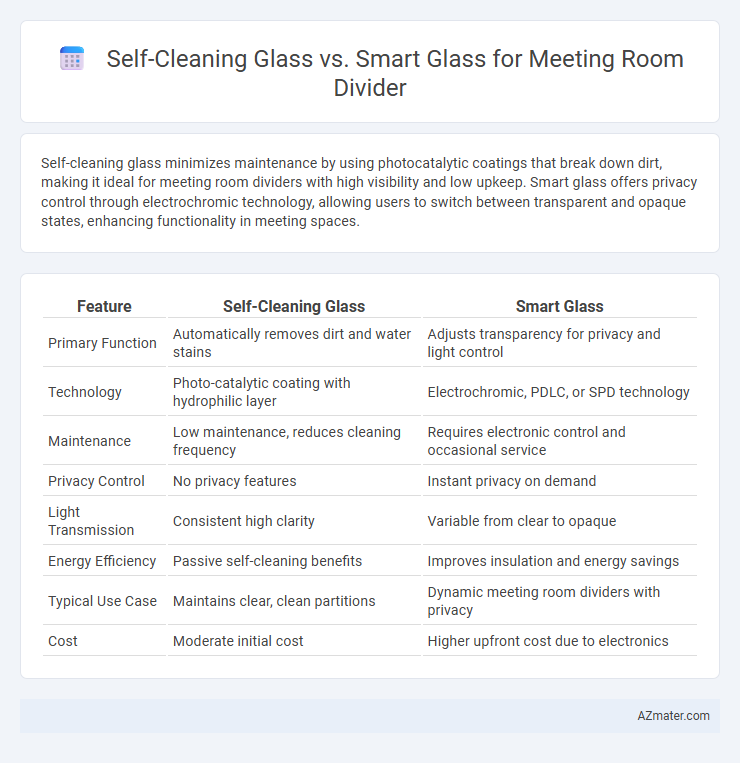Self-cleaning glass minimizes maintenance by using photocatalytic coatings that break down dirt, making it ideal for meeting room dividers with high visibility and low upkeep. Smart glass offers privacy control through electrochromic technology, allowing users to switch between transparent and opaque states, enhancing functionality in meeting spaces.
Table of Comparison
| Feature | Self-Cleaning Glass | Smart Glass |
|---|---|---|
| Primary Function | Automatically removes dirt and water stains | Adjusts transparency for privacy and light control |
| Technology | Photo-catalytic coating with hydrophilic layer | Electrochromic, PDLC, or SPD technology |
| Maintenance | Low maintenance, reduces cleaning frequency | Requires electronic control and occasional service |
| Privacy Control | No privacy features | Instant privacy on demand |
| Light Transmission | Consistent high clarity | Variable from clear to opaque |
| Energy Efficiency | Passive self-cleaning benefits | Improves insulation and energy savings |
| Typical Use Case | Maintains clear, clean partitions | Dynamic meeting room dividers with privacy |
| Cost | Moderate initial cost | Higher upfront cost due to electronics |
Introduction to Modern Meeting Room Dividers
Modern meeting room dividers utilize advanced glass technologies such as self-cleaning glass and smart glass to enhance functionality and aesthetics. Self-cleaning glass minimizes maintenance by using photocatalytic and hydrophilic coatings that break down and wash away dirt automatically. Smart glass offers adjustable opacity or transparency through electrochromic or suspended particle technology, providing privacy control and adaptable lighting conditions for efficient meeting environments.
What is Self-Cleaning Glass?
Self-cleaning glass features a special coating that breaks down organic dirt using sunlight and allows rainwater to wash it away, reducing maintenance for meeting room dividers. Unlike smart glass, which changes opacity or transparency electronically to control privacy and light, self-cleaning glass highlights convenience by minimizing cleaning efforts in high-use office spaces. This technology boosts durability and clarity, ensuring meeting rooms remain visually appealing and hygienic with minimal upkeep.
What is Smart Glass?
Smart glass for meeting room dividers dynamically controls light transmission and privacy through electrochromic or liquid crystal technologies, allowing instant switch from transparent to opaque states. Unlike self-cleaning glass that uses photocatalytic coatings to break down dirt and reduce maintenance, smart glass enhances room ambiance and data privacy without physical blinds or curtains. Its energy efficiency and customizable opacity make it ideal for modern office environments requiring flexible space management and natural light control.
Key Features of Self-Cleaning Glass
Self-cleaning glass for meeting room dividers features a special photocatalytic coating that breaks down organic dirt when exposed to sunlight, reducing the need for manual cleaning and maintenance. It utilizes hydrophilic properties to ensure water spreads evenly across the surface, washing away debris and preventing streaks or water marks. This technology enhances transparency and durability, making it ideal for maintaining a clear, professional appearance in shared workspace environments.
Key Features of Smart Glass
Smart glass for meeting room dividers features electrochromic technology that allows instant adjustment of opacity, providing privacy on demand while maintaining natural light flow. It enhances energy efficiency by controlling heat and glare, reducing HVAC costs and improving occupant comfort. Integration with building automation systems enables seamless control through smartphones or voice commands, optimizing meeting space usability.
Comparing Functionality: Self-Cleaning vs Smart Glass
Self-cleaning glass for meeting room dividers uses photocatalytic coatings to break down organic dirt and hydrophilic surfaces to prevent water spots, minimizing maintenance needs and ensuring clear visibility over time. Smart glass employs electrochromic or liquid crystal technology to switch between transparent and opaque states, offering dynamic privacy and light control tailored to meeting requirements. While self-cleaning glass excels in reducing cleaning frequency, smart glass provides adaptive functionality essential for privacy management in collaborative work environments.
Privacy and Aesthetic Benefits
Self-cleaning glass offers a sleek, transparent surface that reduces maintenance while maintaining clear visibility, ideal for open meeting spaces prioritizing natural light and modern aesthetics. Smart glass enhances privacy by instantly switching from transparent to opaque with the touch of a button, providing customizable visual barriers without sacrificing style. Combining these technologies in meeting room dividers balances easy upkeep with dynamic privacy control and contemporary design appeal.
Maintenance Requirements
Self-cleaning glass significantly reduces maintenance by using a photocatalytic coating that breaks down organic dirt and a hydrophilic surface that allows rainwater to wash away residues, minimizing manual cleaning efforts. Smart glass requires regular monitoring and occasional calibration of its electrochromic or suspended particle technology to maintain optimal functionality and clarity. Compared to smart glass, self-cleaning glass offers lower ongoing maintenance costs and less frequent intervention, making it ideal for meeting room dividers in busy office environments.
Cost Considerations and Longevity
Self-cleaning glass offers lower maintenance costs due to its hydrophobic coating that reduces dirt accumulation, making it cost-effective for long-term use in meeting room dividers. Smart glass, featuring electrochromic or polymer-dispersed liquid crystal technologies, involves higher upfront expenses and potential replacement costs linked to its electronic components, yet provides dynamic light control and privacy. Longevity of self-cleaning glass typically exceeds 10 years with minimal degradation, whereas smart glass panels may have a lifespan of 7 to 12 years depending on usage intensity and environmental factors, impacting the total cost of ownership.
Choosing the Right Glass for Meeting Room Dividers
Self-cleaning glass for meeting room dividers offers low maintenance with its hydrophilic coating that breaks down dirt and repels water, ensuring clear visibility and reduced cleaning efforts. Smart glass provides dynamic privacy control by switching from transparent to opaque at the touch of a button, enhancing flexibility for presentations and confidential discussions. Choosing the right glass depends on balancing the need for effortless upkeep with the requirement for adaptable privacy and aesthetic design in the meeting space.

Infographic: Self-cleaning glass vs Smart glass for Meeting room divider
 azmater.com
azmater.com